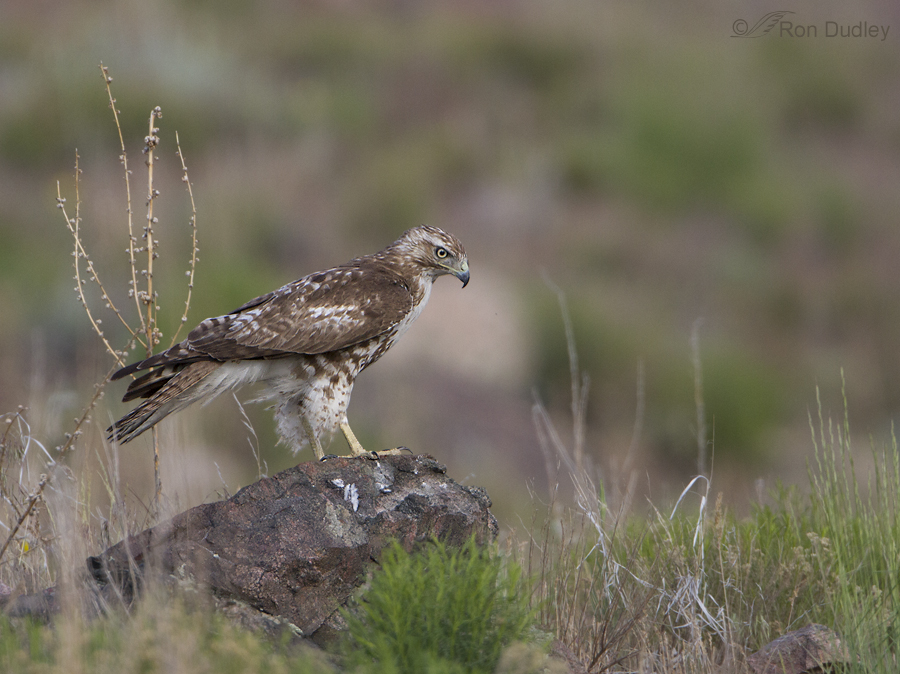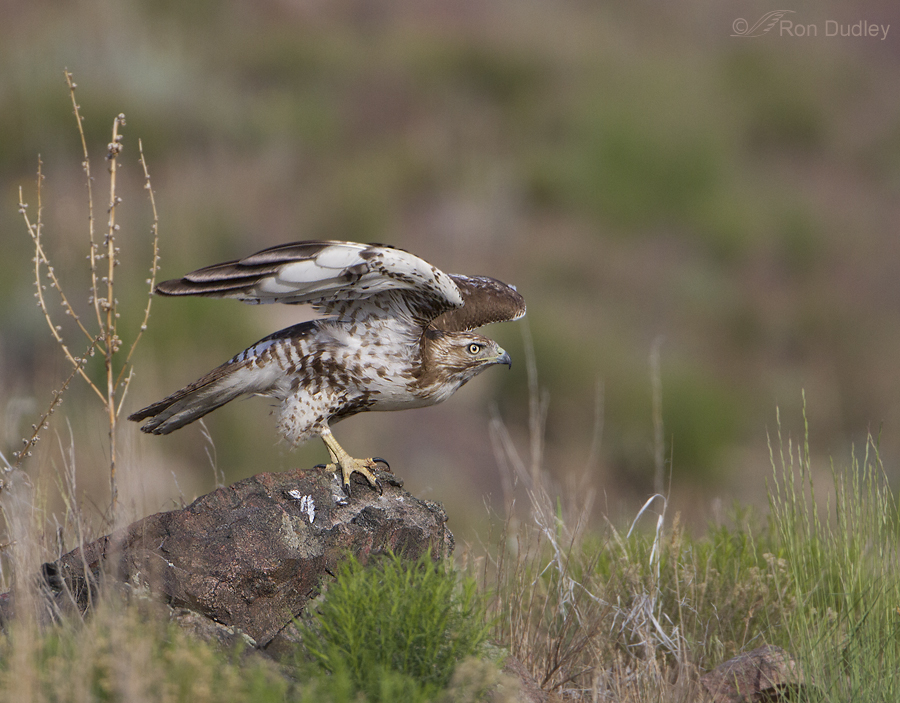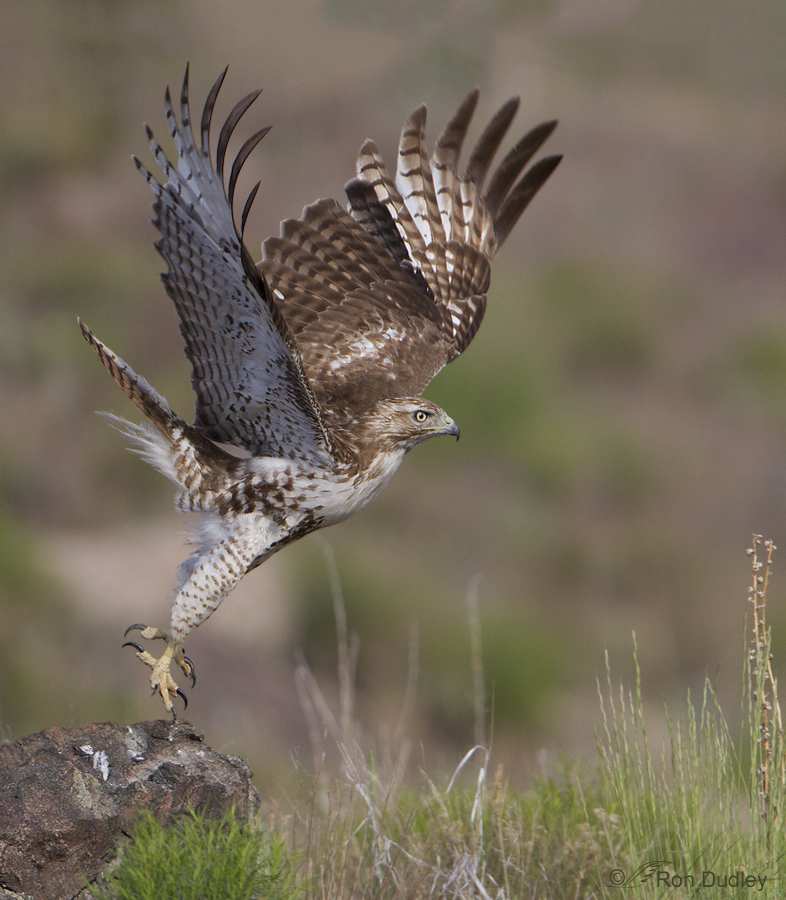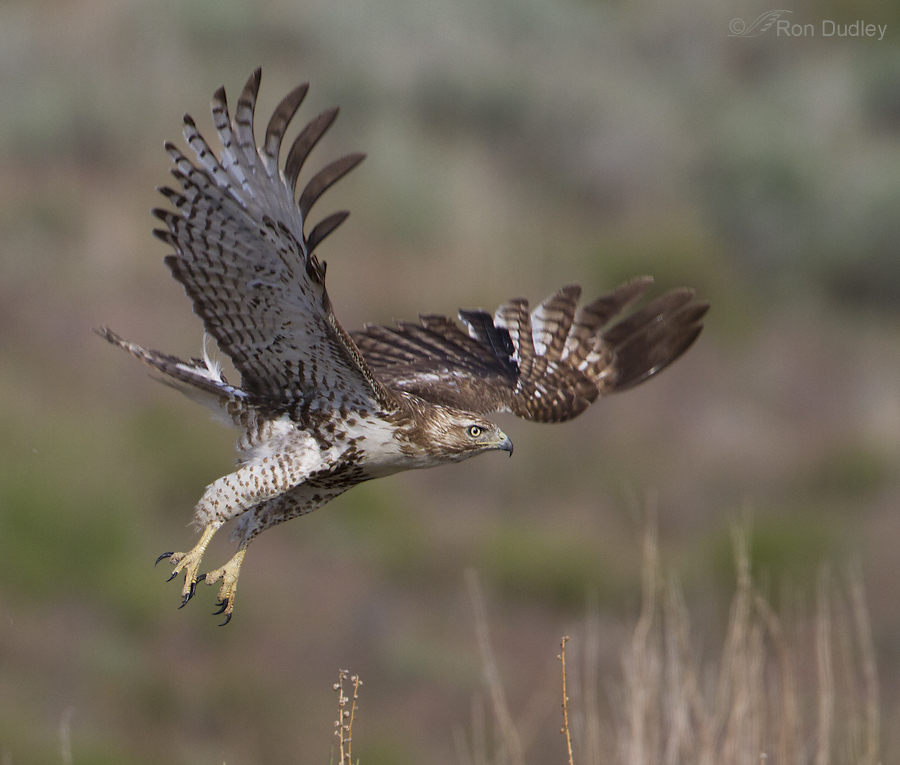Yesterday we found this juvenile Red-tailed Hawk perched on one of the darker Farmington Canyon Complex rocks on Antelope Island. As I’ve said before I much prefer these rocks as perches over the almost white Tintic Quartzite rocks (as in yesterday’s Willet post) that predominate on the north end of the island.
1/1250, f/5.6, ISO 640, 500 f/4, 1.4 tc, not baited, set up or called in
I thought the generally light coloration of this bird to be slightly unusual but I’m certainly no expert on the color phases and morphs of this highly variable species. The hawk was a little too far away for high quality images as the bird was perched but I hoped for take-off so those dramatic open wings would help to fill the frame in flight.
1/2000, f/5.6, ISO 640, 500 f/4, 1.4 tc, not baited, set up or called in
The hawk defecated which signaled imminent lift-off but my concern was keeping it in frame as it flew. It was on a hillside which slopes down to my right and it might follow the slope close to the ground as it used its weight to increase momentum or attempt to gain altitude immediately. There’s no way to anticipate what they’re going to do and I just hoped that I’d be able to track it.
1/2000, f/5.6, ISO 640, 500 f/4, 1.4 tc, not baited, set up or called in, canvas added up top
I fired a burst just as it launched and I like the tension and energy in this outstretched posture.
1/2000, f/5.6, ISO 640, 500 f/4, 1.4 tc, not baited, set up or called in
The first down stroke caught the head between the wings but since the head is sharp and darker (even in this light individual) than the underside of the wing I think it stands out enough to make an effective image.
1/2000, f/5.6, ISO 640, 500 f/4, 1.4 tc, not baited, set up or called in
In the end the hawk flew low and followed the slope of the hill as it gained speed. After this shot there was vegetation in the foreground and I lost focus.
I haven’t had any good opportunities with red-tails on the island for quite a while so I was delighted to finally find a somewhat cooperative bird once again.
Ron
Note: I’d be interested if any of you raptor experts have any thoughts on the coloration of this hawk. Am I correct in thinking that this bird varies a bit from the norm?







I’m no expert on anything Ron, but I’m with Mr. Shaw on this one. Lice do not affect the melanin levels in birds, so that is not the explanation. As feathers age, they fade. This bird does not seem unusual to me. Birds at this time of year can be freaky looking, especially when worn. This bird is one year old and molting as well, so it might be the explanation for its lighter appearance. If you want a really solid answer, I’d ask Jerry, but I’m pretty sure this is just a typical young RT in spring. I’m glad you shared this though. Helps me think about things and learn myself!
Love your Red-tail shots Ron! Yes they’re common, but beautiful photography trumps the tendency to take them for granted. This Western juvenile’s head, and particularly it’s eyeline, is a little on the light side, but not out of the norm. Kind of like a towhead is to a dirty blonde.
Making discovery of your blog has added a dimension to my love of the natural world and the birds who live with us in particular. I’ve been a birder for 7 years and there is always so much more to learn about them … Thanks for your posts and your photos! We don’t get to see the movement and habits of birds in slow mo and your passion manifests as a bridge into their world. Deep bows and gratitude for your patient pursuit and intimate relationship with these magnificent creatures.
Dawna
San Francisco
Your posts (with the exception of those relating to thievery) brighten my world. This is a stunning bird (and yes, I love his britches) and I am so grateful to learn from you, and from the very knowledgeable people who also visit. Thank you all so very much.
I love your “britches” comments, Elephant’s Child. I hope you are doing well…
As a special birthday present to our son, MIchael, an environmentally aware architect in Buffalo, NY, I told him about your incredible photos, especially these new ones of the young red-tailed. I can’t wait to hear his comments.
I hope he likes them, Patty.
When I was living in Richmond, VA I saw lots of red tails and they were all light colored. These are gorgeous shots!
We get quite a variety of color tones with them around here, Susan. Thank you.
Those shots are remarkable. My first thought was to ask if I could paint him, but then I thought maybe someone would take me seriously. (It’s tough to grin and use inflection on a blog comment)
Anyhow, I’m not kidding about how beautiful the captures were, and I loved the comment you made about the tension and energy as it took off. They are so impressive!
I’m delighted that you like the images, Cindy. Thank you. And I know what you mean about trying to get inflection across in a blog comment…
I agree that the coloration on this immy red-tail looks normal to me. We do see some dark phase birds out here and an occasional Harlan’s. I like Mark Runnel’s explanation of the damage from feather lice as a possible answer to why he seems to have more white … the lice really do chew the white parts of the feathers extensively, leaving more of the dark.
Thanks, Louise. It’s great to know that your experience echos what Mark said about the lice eating more of the white parts of the feathers.
I think my laptop is playing tricks on me…all 4 pictures came through this time…took longer than usual but I got them all. Your photos are so magnificent, I don’t want to miss anything! Happy holidays.
Love the “spread fingers” look of the primaries. These are remarkable pictures of one of my favorite birds…The golden eagles”s little brother. The comments from experienced birders are priceless. My first picture area was a white square…did I miss something?
I’m glad you got the first shot to load later on, Patty. I was in the field when I got your comment on my phone but I was able to load all the images then on my phone. I agree, the comments that my knowledgeable readers make here are worth their weight in gold!
Greeting from the islands Ron! We have seen a ton of birds here including a solid black hawk that I have not yet identified.
The bird in the picture is a lucky specimen of a very normal colored, immature red tail. Every year we catch 50-60 Red tails as a byproduct of peregrine trapping, almost all are immature, or as we term them, “passage” birds. In addition thousands of these wonderful birds winter in our area. Ann and I have become something if students if the color variations and we are especially interested in predicting the bird’s mature coloration from its immature plumage. About 5% of the birds we see or catch are extremely light, or Krider’s hawks; another 4-5% will be pure black and marked like a golden eagle, these are termed Harlan’s hawks, with a spectrum of colors in between. Of course, I sent you pictures of the one we found that was pure white, or amelanistic, last year.
Back to the bird in your wonderful photos. This is a perfect example of a normal colored red tail. What makes him (I think it’s a he based on foot size and body shape) appear lighter is a very low level of feather lice damage. A normal red tail body feather is brown with half moons of white on each side. Feather lice infect almost all red tails from the time the begin to fledge. For reasons I have never been able to explain, the lice loading is much lighter in adults (teenagers wash less?) The feather lice only eat the white parts of the feathers and leave the brown alone. So two birds that start out looking exactly like the bird in your picture will change over time. As it gets older, the one with the higher lice load will become progressively more brown until there is almost no white left on it. This bird is apparently only recently fledged and/or has an unusually low lice loading. It will be interesting to see if you can shoot him again in a few weeks or months to see how, or if, his coloration changes.
See you later, Mon!
Mark
Fantastic info about the lice doing this to the feathers, Mark. I had no idea! Very interesting that the lice only eat the whites of the feathers. This makes me wonder if there could be some sort of symbiotic relationship going on here (a stretch I know, but still…) I’ll definitely see if I can photograph this bird in a few weeks and see if there’s been any change. Fascinating stuff! Thank you.
I didn’t know about the lice habit either! I’ve always noticed the saw-tooth pattern of lice infested feathers when trapping passage hawks. This would explain why birds with lice have such a strong pattern. Fussy lice….who’da guessed.
Thanks for sharing your incredible shots and wonderful commentary.
It is gratifying to know that your loyal fans were able to put pressure on the thief and shut her down. It will be interesting to see if she just lays low for a while and then resurfaces.
Charlotte
Thanks very much, Charlotte.
He’s molting, and losing a small feathers around the head which might give him a lighter look. It’s not unusual for RT’s to be light colored. In my area..maybe a 2 mile radius…there are a few dark phase RT’s as well as light. Here’s a note in my “file O’stuff” on coloring:
“Red-tailed Hawks have extremely variable plumage, and some of this variation is regional. A Great Plains race called “Krider’s” hawk is pale, with a whitish head and washed-out pink in the tail. Light-phase western birds tend to be more streaky on the underparts than eastern Red-tails; south Texas forms are darker above, without the dark belly band most other Red-tails have. Dark-phase birds can occur anywhere but are more common in western North America – particularly in Alaska and northwest Canada, where the all-dark “Harlan’s” race is common.”
allaboutbirds.org
Interesting stuff, Tim.
I’m no expert, although I’ve been birding for 65 years, I would characterize this juvenile as typical. It has been my experience that juveniles of all the different morphs one can find of this species, except for Harlan, look pretty similar. I have only seen a Harlan adult once, so if you are thinking it might be a juve of that morph, can’t help you, he just looks like a lot of juve red tails I’ve seen. Sorry.
Great shots though, even from a distance, wonderful, clear and sharp!
From the comments of others it looks like you’re right, Dick. Thank you.
So beautiful!
Thanks, Sharon.